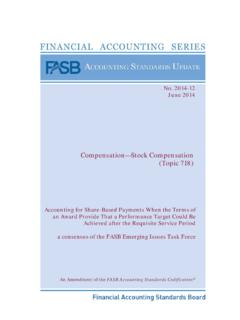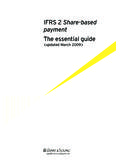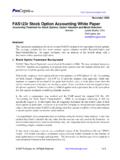Transcription of Insurance Accrual Accounting - World Bank
1 Insurance Reichertnon-bank financial institutions groupglobal capital markets development departmentfinancial and private sector development vice presidencyprimer series on insuranceissue 6, june 1-25/20/09 12:17:15 Insurance AccrualAccountingOliver Reichertnon-bank financial institutions groupglobal capital markets development departmentfinancial and private sector development vice presidencyprimer series on insuranceissue 6, june 15/20/09 12:15:50 Asset Structures for Insurersii 2009 The International Bank for Reconstruction and Development/The World Bank1818 H Street, NWWashington, DC 20433 Internet: : rights printing June 2009 This volume is a product of the staff of the International Bank for Reconstruction and Development/The World Bank. The findings, interpretations, and conclusions expressed in this paper do not necessarily reflect the views of the Executive Directors of The World Bank or the governments they World Bank does not guarantee the accuracy of the data included in this work.
2 The boundaries, colors, denominations, and other information shown on any map in this work do not imply any judgement on the part of The World Bank concerning the legal status of any territory or the endorsement or acceptance of such and publication design: James E. QuigleyCover illustration: Imagezoo/CorbisAuthor Oliver Reichert, , FCPA, FCIS, MAICD, has worked exclusively in the financial services industry for the past 23 years, both as a senior executive and as a consultant to industry. In addition, he has chaired a number of Insurance industry forums and has published articles on topical financial services the World Bank and the Asian Development Bank, Oliver has worked with 15 national regulators of non-bank financial institutions in Eastern Europe, Asia and Africa since 2001. His focus is to assist Governments of emerging economies to develop their Insurance industries by improving Insurance Accounting standards, Insurance regulations and Insurance supervision through risk based methodology.
3 THIS ISSUES eries editor Rodolfo Wehrhahn is a senior Insurance specialist at the World Bank. He joined the Bank in 2008 after 15 years in the private reinsurance and Insurance sector and 10 years in academic research. Before joining the World Bank, he served as President of the Federation of the Interamerican Insurance Associations representing the American Council of Life Insurers. He was board member of the AEGON Insurance and Pension Companies in Mexico, and was CEO of reinsurance operations for Latin America for Munich Reinsurance and for questions about this primer, or to request additional copies, please The Primer Series on Insurance provides a summary overview of how the Insurance industry works, the main challenges of supervision, and key product areas. The series is intended for policymakers, governmental officials, and financial sector generalists who are involved with the Insurance sector.
4 The monthly primer series, launched in February 2009 by the World Bank s Insurance Program, is written in a straightforward, non-technical style to share concepts and lessons about Insurance with a broad community of Non-Bank Financial Institutions Group in the Global Capital Markets Development Depart-ment aims to promote the healthy development of Insurance , housing finance, and pension markets, and to expand access to a broad spectrum of financial services among the poor. These markets provide opportunities for household investment and long-term savings, and can buf-fer the poor against the risks of sickness, loss of breadwinner, catastrophic events, and other 25/20/09 12:15:50iiiContentsIntroduction ..1 Unique Insurance industry features ..2 The profit and loss statement ..3 The balance sheet ..8 Accounting for solvency and Accounting for profit ..11 Insurance Accounting for profit.
5 12 Insurance Accounting for solvency ..15 Insurance Accounting in developing countries ..15 Should developing countries be encouraged to adopt IFRS or US GAAP? ..18 Appendix A: Simplified Non-Life/P&C Insurance Profit and Loss Used in Developed Countries ..20 Appendix B: Simplified Insurance Profit and Loss Used in Developing Countries .. 35/20/09 12:15:501 Insurance AccrualAccountingOliver ReichertIntroductionAll companies, no matter which industry they operate in, need to prepare financial statements consisting of a profit and loss account, a balance sheet, funds flow statement and notes to the accounts. These accounts must reflect a true and fair picture of the financial perfor-mance and financial position of the company. Insurance companies are no exception, but the nature of Insurance is sufficiently unique that special Accounting standards have been most industries the period between a products or services sale and subsequent payment by the consumer and delivery by the vendor is relatively short.
6 In the Insurance industry, this is not the case: an Insurance policy can be sold with premiums being due and payable (usually annually) for decades after the contract becomes effective. Similarly, benefits receivable from owning an Insurance policy can also take decades to be determined and subsequently settled. Thus oper-ating cycles and financial and management reporting cycles tend to be very different, leading inevitably to significant Accounting entries at balance dates representing accrued Insurance liabilities and receivables. Accrued Insurance liabilities are typically the largest item on a insur-ance entity s balance addition many Insurance contracts include embedded options favoring the policyholder. Examples include implicit or explicit minimum investment return guarantees, the right to surrender early, the right to vary the savings and risk components of a Universal Life contract and the right to renew cover under a yearly renewable term 15/20/09 12:15:51 Insurance Accrual Accounting2life contract.
7 These options should be valued and shown as liabilities to the extent that they cannot be for Insurance must take these factors into consideration via Accrual Accounting methodology. This often involves estimating future states of nature and factoring these estimates into complex discounted flow Insurance industry featuresKey features of the Insurance business are: Policy acquisition: as is the case with all business, the Insurance industry is sales driven. It is very costly for an Insurance company to acquire, or sell an Insurance policy: initial commissions to Insurance agents or brokers are high. Furthermore, expenses related to the evaluation process as to whether to accept an individual policyholder are also high: for example, in the case of a life Insurance policy, this may involve a doctor s examina-tion, including blood tests. Therefore, the cash outflow related to putting a policy on the books can frequently exceed the cash received for the first year s premium.
8 These acquisition costs are generally deferred and recovered from the Insurance premium inflow which will take place over the following years. Premium income: frequently, premiums are paid by policyholders over a number of years. Premiums received for the current year are accounted for as income. Premiums received/receivable for future years effectively represent an asset of the Insurance company. The quantification of this asset is a complex matter, partially as the duration of the policy cannot be calculated accu-rately: for example, in the case of certain types of policies, the Insurance company does not have the right to cancel a policy once it has been accepted through the underwriting process. The policyholder, however, may cancel the policy at any stage. Claims and Benefits payable to policyholders: the cash outflow relating to insured events is uncertain. An insured event for a specific policy may never take place, such as an auto theft, or a building fire.
9 Alternatively, an insured event may take place much more quickly than contemplated, such as an accidental death of a policyholder who recently purchased a life Insurance policy. Claims and benefits payable to policyholders need to be accounted for as a liability of the Insurance company, and as noted it is a complex matter to quantify this 25/20/09 12:15:51 Insurance Accrual Accounting3 These features usually give rise to large differences between cash flow and Accounting for profit in any one year. Thus the cash based Accounting still used in a number of jurisdictions provides a poor, and almost always overly optimistic, picture of the performance and finan-cial position of the insurers reality, no matter how these cash flows are accounted for, the profit, or loss, on any one policy will be the same over the life of the Insurance policy. However, Insurance companies are legally required to produce statements of profits and losses, and balance sheets, at least annually.
10 As part of the Insurance Accounting Accrual process, they must therefore estimate, on an annual basis, as accurately as possible: The deferral of acquisition costs; The cash inflows from premiums payable in future years; and Claims and benefits payable to policyholders including those that have already occurred and are yet to be fully settled and those that will occur in the called actuaries are required to carry out some of these calculations. A paper dealing with the work of actuaries is included as module 7 of the Insurance primer further important factor, although by no means unique to the Insurance industry (the banking industry, in particular, has a similar issue) is the importance of matching the duration of investment assets with the estimated duration of policyholder liabilities, and holding sufficient capital if there is a mismatch. This matter is dealt with in further detail in the section on investment profit and loss statementThe Profit and Loss Statement consists of the following Insurance -specific items:Revenuepremium incomeThe major income source for Insurance companies is premiums received.
















